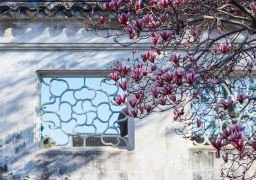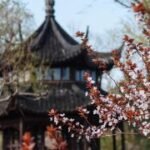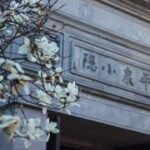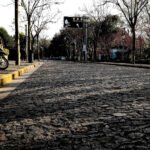The Master of the Nets Garden is a quintessential Suzhou garden, covering an area less than one-sixth that of the Humble Administrator’s Garden, yet its ingenious layout avoids the cramped feel of small bridges, flowing waters, pavilions, and towers. It is an exemplary model of ‘seeing the large in the small.’ In addition to understanding the subtleties of its layout, another highlight is enjoying traditional Chinese music and performance art during the annual night garden opening. The garden was originally built during the Southern Song Dynasty’s Chunxi period (AD 1174-1189), on the site of the ‘Hall of Ten Thousand Volumes,’ with the garden named ‘Fishing Hidden,’ which, like its current name, signifies retreating from the world. Most of the garden’s features that visitors see today are remnants from the late Qing Dynasty’s Qianlong period after restoration and expansion. The garden’s centerpiece is a large pond, the ‘Pool of Rosy Clouds,’ around which all structures are arranged. The eastern part is the residential area, the northern part is the study area, the western part is the inner garden area, and the southern part is the entertainment area. There are two gates to the garden, the north gate (rear gate) and the southeast gate (main entrance). It is recommended to enter through the southeast gate and tour the garden counterclockwise around the pond to view all the structures. In the eastern area, from south to north, are the sedan chair hall, the main hall ‘Hall of Ten Thousand Volumes,’ the ‘Picking Excellence’ building for the owner’s living and receiving guests, the ‘Five Peaks Study’ for book storage (original site of the Southern Song ‘Hall of Ten Thousand Volumes’), and the ‘Ladder to Clouds’ room to the northeast of the Five Peaks Study. The sedan chair hall contains a sedan chair with intricate, nearly hollow carvings. The gate towers opposite the ‘Hall of Ten Thousand Volumes’ and in front of the ‘Picking Excellence’ building both feature exquisite brick carvings, while the ‘Ladder to Clouds’ room boasts beautiful wood carvings on its doors and windows. These are points to pay attention to during the tour. From the Five Peaks Study, follow the northern edge of the ‘Pool of Rosy Clouds’ westward to tour the northern area of the garden. To the west of the Five Peaks Study is the ‘Empty Gathering’ study, used by the owner for reading, and the ‘Bamboo Branch’ study, used by the owner’s children for reading. Further west is the ‘Pine Reading and Painting Appreciation’ pavilion, a place to appreciate the garden’s scenery, with pine and cypress trees planted in front. In spring, one can enjoy the flowers; in summer, listen to the cicadas; in autumn, smell the osmanthus fragrance; in winter, observe the snow covering the pine and cypress, with each season presenting a picturesque scene. The term ‘reading paintings’ is very fitting. Continuing westward leads to a relatively independent area—the inner garden area in the west. The painter Zhang Daqian once lived in the ‘Hall of Spring’s End’ in the inner garden and even kept a tiger in the courtyard to better paint it. After the tiger’s death, Zhang Daqian erected a tombstone for it, which can still be seen under the semi-kiosk on the westernmost wall of the garden. Moving southward, one arrives at the ‘Moon Arrival and Wind Coming’ pavilion, located in the middle of the western garden, facing the ‘Pool of Rosy Clouds.’ The pavilion offers a serene reflection of the surrounding black-tiled, white-walled structures in the water. At night, it becomes an excellent spot for moon viewing. Inside the pavilion, there is a large mirror that visually expands the space. Further south, passing through the ‘Rinsing the Tassels’ water pavilion, one reaches the southern area of the garden, which includes the ‘Qin’ room for the owner’s qin (zither) playing and the ‘Dance and Harmony’ pavilion for leisure.
Ascend the artificial hillock, crafted from yellow stones, to the east to overlook the garden’s exquisite scenery. Continuing further east, you will pass by the Small Hill Hall of Cassia, where the master of the house lived and received guests. Here, you can see a super miniature bridge, named the ‘Bridge of Serenity’, lying over a small stream. This bridge is a famous structure in Wang Shi Yuan, with five steps on each side and can be crossed in just three strides. The bridge is located at the confluence of the stream and the Rosy Cloud Pond, its smallness contrasting to make the pond appear vast and the garden’s space seem larger. To the north of Wang Shi Yuan is Shi Quan Street, a renowned dining and craft specialty street in Suzhou. Not only Shi Quan Street, but also the intersecting Feng Huang Street is lined with numerous restaurants, such as the Old Suzhou Tea and Wine Building and the Harmony Restaurant, which serve authentic Suzhou cuisine like squirrel-shaped mandarin fish, oil-burst eel paste, and green snail shrimps. Craft items for sale include Suzhou embroidery, calligraphy, and silk. Nearby accommodations include the Nanlin Hotel, Suzhou Residence Hotel, and Nan Garden Hotel. The area also features the scenic spot, the Cang Lang Pavilion, which can be visited together. Wang Shi Night Garden is a classic Suzhou tourism product and a well-known tourism brand recognized worldwide, recommended by UNESCO as a specific tourism project. As a long-standing highlight of Suzhou’s night tours, after thirty years of evolution and refinement, the Wang Shi Night Garden returned in March 2021 with a new experience! The newly upgraded night tour of Wang Shi Garden offers a richer sense of participation and experience. Combining the garden’s real scenery with intangible cultural heritage performances and installation art, and using air sachets to blend fragrances with dynamic art forms from all aspects of ‘form, sound, smell, taste, and touch’, it brings a beautiful mood and viewing experience, achieving a creative integration of ancient gardens and traditional arts, effectively expressing the ‘ultimate small garden’ beauty of Wang Shi Garden at night. The night tour performance includes programs such as Suzhou storytelling, Kunqu Opera, Kunqu singing, Kunqu dancing, flute and xiao, ancient zither, and tea tasting, with a total duration of about 45 minutes. Breaking the conventional passive viewing, the audience actively explores the clues of the garden’s story, moving through different scenes and enjoying a play every ten steps, using the garden to showcase intangible cultural heritage and interpreting the garden through it. Open daily from March 1st to October 31st from 07:30 to 17:30; from November 1st to February 28th from 07:30 to 17:00. Concessions: Children: Under 1.4 meters in height (inclusive) or under 6 years old (inclusive) with valid ID, free; minors aged 6 to 18 years old (inclusive) with valid ID, concession ticket. Students: Full-time undergraduate students and below with valid ID, concession ticket. Elderly: Elderly aged 60 to 70 years old (inclusive) with valid ID, concession ticket; those aged 70 and above with valid ID, free. Military personnel: Active duty military personnel of the People’s Republic of China with military ID and retired military personnel with retirement ID, free. Disabled: With ‘Disability Certificate’, free entry; severely disabled persons requiring companionship can have one accompanying person enter for free, free concessions. Beneficiaries: With ‘People’s Republic of China Veterans’ Benefit Certificate’, ‘People’s Republic of China Martyrs, Military Personnel Who Died in Public Service, and Deceased Military Personnel’s Dependents Benefit Certificate’ (excluding garden within the garden, garden charges, and night tour projects), free. Suzhou medical staff: Free to visit the scenic spot within 7 days from May 12th International Nurses’ Day and August 19th Chinese Physicians’ Day (May 12th to 18th, August 19th to 25th).


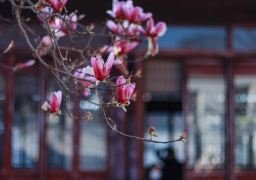
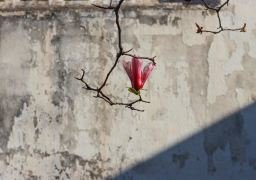
For medical personnel in Suzhou City, when visiting the scenic area, please show ‘personal ID card’ + ‘Suzhou medical personnel free park card (electronic card)’. They can enter the park directly without reservation and are exempt from the first entrance ticket fee. Free service facilities WIFI: Account: Master-of-Nets Garden; Password: No password required; Scope: Tourist service center in the scenic area. Luggage storage: Reference price: Free. Scenic area interpretation: Manual interpretation services are provided at the sedan hall at the scenic area entrance. Cost: Free. Tour guide service (Free interpretation times are: 8:20/9:00/9:40/10:20/11:00/12:30/13:10/13:50/14:30/15:10/15:50); Paid tour guide service (1-5 people, 60 yuan; 6-10 people, 80 yuan; 11-20 people, 100 yuan; more than 20 people, 140 yuan). Toilets: There are multiple toilets in the Master-of-Nets Garden scenic area, which are located near Yunku and Luhua Pavilion respectively and are marked with eye-catching signs.
